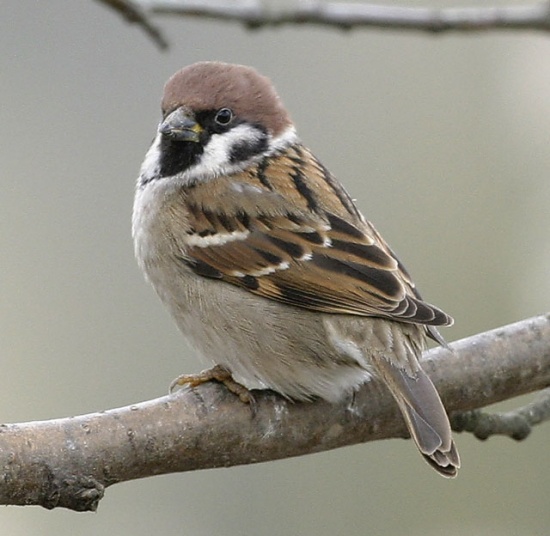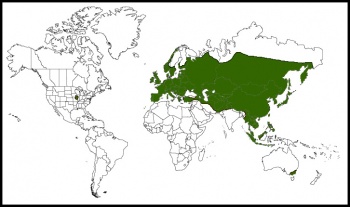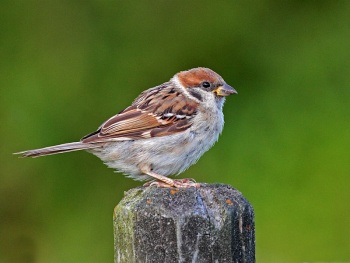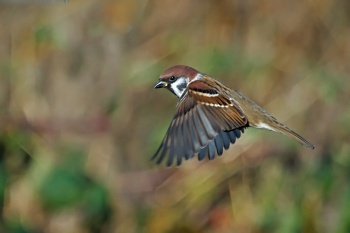(taxon, refs) |
(→External Links: Multiple GSearches combined) |
||
| Line 67: | Line 67: | ||
==External Links== | ==External Links== | ||
Search the Gallery using the scientific name: | Search the Gallery using the scientific name: | ||
| − | {{GSearch|Passer | + | {{GSearch|"Passer montanus" {{!}} "Eurasian Tree Sparrow" {{!}} "Tree Sparrow" {{!}} "European Tree Sparrow"}} |
| − | + | {{GS-checked}}1 | |
| − | |||
| − | {{ | ||
| − | {{GS-checked}} | ||
<br /> | <br /> | ||
<br /> | <br /> | ||
[[Category:Birds]] [[Category:Passer]][[Category:Bird Songs]] [[Category:Maps]] | [[Category:Birds]] [[Category:Passer]][[Category:Bird Songs]] [[Category:Maps]] | ||
Revision as of 22:44, 1 February 2023
Alternative names: Tree Sparrow; European Tree Sparrow
- Passer montanus
Identification
14 - 15 cm. (5½-6 in.) A small, neat-looking sparrow:
- Chestnut crown and nape
- White cheeks with a black spot
- Small black bib not expanding on breast
- Narrow white neck-collar
- Black-streaked brown back
- Distinct white wing-bar
- Dusky underparts
Sexes are alike. Juvenile is duller with grayish central crown patch blending into reddish brown on the sides of crown and indistinct dark ear-patch.
Variations
The subspecies mainly differ in plumage tones and in size. Those in arid regions tend to be paler (eg. dilutus), those in tropical humid areas darker (eg. malaccensis)
Similar Species
House Sparrow has a grey head and lacks the white cheeks.
Distribution
| Widespread from Europe east over Russia to China and southeast Asia. Introduced populations in Australia and the US (St. Louis, Missouri). In Europe breeds in coastal Ireland and Britain (but rather uncommon in the north), and from western France, north and eastern Iberia east across Europe to the Urals and Caspian reaching coastal and southern Scandinavia, the Baltic States and the White Sea. In the south occurs on the Mediterranean coasts of Spain and France, Italy and Sicily, the Balkans, patchily in west, central and northern Turkey and the Caucasus. Formerly bred in the Faroes and has bred Morocco, recently in Malta and Gozo] introduced to Sardinia.
Rare breeder in the Canary Islands, found only on Gran Canaria. | |
| Legend • Passer montanus; year-round |
Taxonomy
Subspecies
There are 9 subspecies[1]:
- P. m. montanus: Europe to north Africa, northern Mongolia, Manchuria and Sea of Okhotsk
- P. m. dybowskii: Eastern Asia (lower Amur River to Manchuria and northern Korea)
- P. m. transcaucasicus: Southern Caucasus (Black Sea coast of Georgia to northern Iran)
- Generally duller and greyer above, whiter below
- P. m. kansuensis: Western China (Zaidam basin and northern Gansu)
- P. m. tibetanus: southern and eastern Tibetan Plateau and central China (east to southeastern Qinghai and western Sichuan)
- P. m. iubilaeus: Eastern China (Liaoning to lower Yangtze River and Shaanxi)
- P. m. obscuratus: Nepal east to north-eastern India
- P. m. dilutus: Transcaspia to western Pakistan, Gobi Desert and western China (Xinjiang)
- P. m. saturatus: Southern Kuril Island, Japan, South Korea, Ryukyu Island, Taiwan and south-eastern China
- P. m. hepaticus: extreme northeastern India (southeastern Arunachal Pradesh) and adjacent southern China (southeastern Xizang)
- P. m. malaccensis: Central Myanmar, Malaya, Hainan, Vietnam and western Indonesia
Habitat
Open woodland and along woodland edges, parkland and farmland with copses and hedgerows. In parts of the range quite frequent in suburbs or even in urban areas.
Behaviour
Highly gregarious, this bird prefers the vicinity of humans.
Diet
Feeds mainly on seed of herbs, grasses and cereals. Takes also animal food like spiders and insects during breeding season.
Breeding
Secondary cavity nester. Not aggressive or pugnacious like the House Sparrow, but may attempt to claim a box used by another bird. The clutch consists of four to six eggs which are quite variable in their markings. There may be a second brood.
Vocalisation
Listen to Eurasian Tree Sparrow sound clip
References
- Clements, J. F., T. S. Schulenberg, M. J. Iliff, S. M. Billerman, T. A. Fredericks, J. A. Gerbracht, D. Lepage, B. L. Sullivan, and C. L. Wood. 2021. The eBird/Clements checklist of Birds of the World: v2021. Downloaded from https://www.birds.cornell.edu/clementschecklist/download/
- Del Hoyo, J, A Elliott, and D Christie, eds. 2009. Handbook of the Birds of the World. Volume 14: Bush-shrikes to Old World Sparrows. Barcelona: Lynx Edicions. ISBN 978-8496553507
- The Observer's Book of Birds' Eggs ISBN 0723200602
- Barlow, Jon C. and Sheridan N. Leckie. (2000). Eurasian Tree Sparrow (Passer montanus), The Birds of North America (P. G. Rodewald, Ed.). Ithaca: Cornell Lab of Ornithology; Retrieved from the Birds of North America: https://birdsna.org/Species-Account/bna/species/eutspa
- Summers-Smith, D. (2017). Eurasian Tree Sparrow (Passer montanus). In: del Hoyo, J., Elliott, A., Sargatal, J., Christie, D.A. & de Juana, E. (eds.). Handbook of the Birds of the World Alive. Lynx Edicions, Barcelona. (retrieved from http://www.hbw.com/node/60946 on 2 June 2017).
Recommended Citation
- BirdForum Opus contributors. (2024) Eurasian Tree Sparrow. In: BirdForum, the forum for wild birds and birding. Retrieved 24 April 2024 from https://www.birdforum.net/opus/Eurasian_Tree_Sparrow
External Links
Search the Gallery using the scientific name:
GSearch checked for 2020 platform.1







